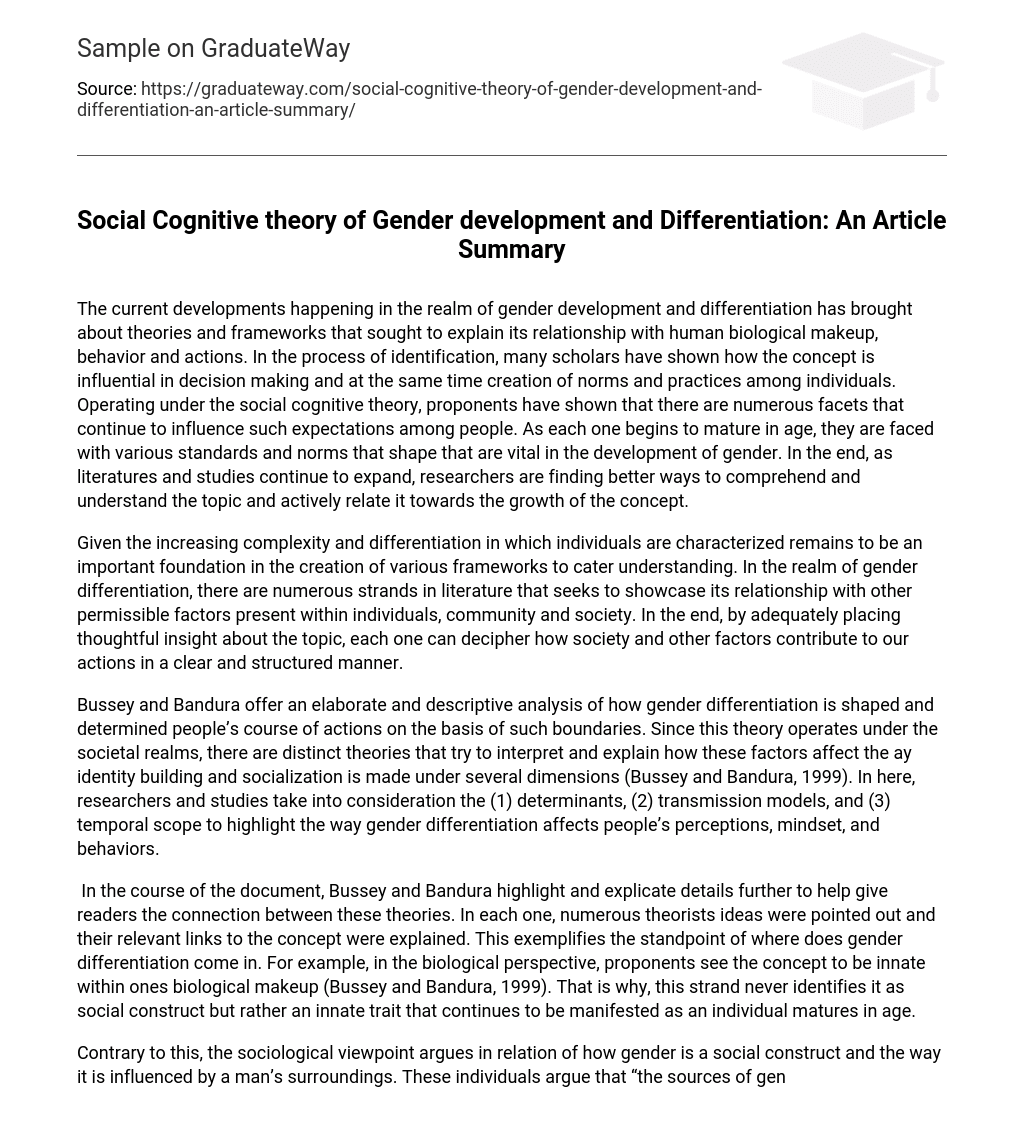The current developments happening in the realm of gender development and differentiation has brought about theories and frameworks that sought to explain its relationship with human biological makeup, behavior and actions. In the process of identification, many scholars have shown how the concept is influential in decision making and at the same time creation of norms and practices among individuals. Operating under the social cognitive theory, proponents have shown that there are numerous facets that continue to influence such expectations among people. As each one begins to mature in age, they are faced with various standards and norms that shape that are vital in the development of gender. In the end, as literatures and studies continue to expand, researchers are finding better ways to comprehend and understand the topic and actively relate it towards the growth of the concept.
Given the increasing complexity and differentiation in which individuals are characterized remains to be an important foundation in the creation of various frameworks to cater understanding. In the realm of gender differentiation, there are numerous strands in literature that seeks to showcase its relationship with other permissible factors present within individuals, community and society. In the end, by adequately placing thoughtful insight about the topic, each one can decipher how society and other factors contribute to our actions in a clear and structured manner.
Bussey and Bandura offer an elaborate and descriptive analysis of how gender differentiation is shaped and determined people’s course of actions on the basis of such boundaries. Since this theory operates under the societal realms, there are distinct theories that try to interpret and explain how these factors affect the ay identity building and socialization is made under several dimensions (Bussey and Bandura, 1999). In here, researchers and studies take into consideration the (1) determinants, (2) transmission models, and (3) temporal scope to highlight the way gender differentiation affects people’s perceptions, mindset, and behaviors.
In the course of the document, Bussey and Bandura highlight and explicate details further to help give readers the connection between these theories. In each one, numerous theorists ideas were pointed out and their relevant links to the concept were explained. This exemplifies the standpoint of where does gender differentiation come in. For example, in the biological perspective, proponents see the concept to be innate within ones biological makeup (Bussey and Bandura, 1999). That is why, this strand never identifies it as social construct but rather an innate trait that continues to be manifested as an individual matures in age.
Contrary to this, the sociological viewpoint argues in relation of how gender is a social construct and the way it is influenced by a man’s surroundings. These individuals argue that “the sources of gender differentiation lie more in the social and institutional practice than in fixed properties of the individual” (Bussey and Bandura, 1999, p. 686). In addition, it takes into consideration the role and importance of the environment in shaping and honing standards and practices appropriate for a particular gender. It is with this activity and social interaction that norms and principles are established within the parameters of gender differentiation.
Other than the conventional theories, the article also puts into consideration the non-conventional approaches that still hold ground in explaining the topic. It also looks into the variables of influence, causal structures, environmental structures and its relative effects to modeling an individual to a prescribed norms and standards. Likewise, the authors also pointed out the way these expectations and practices are regulated accordingly by various institutional and societal models. These mechanisms in turn seek to help maintain the needed expectations among individuals under a particular social institution or environment (Bussey and Bandura, 1999).
Lastly, the document mentions the relative importance of analyzing the role of gender differentiation and how it can be analyzed accordingly. Since it is considered to be a socio-cultural phenomenon by many, there must be appropriate mechanisms and practices that can help individuals understand its role in socialization and how it can contribute to learning and honing of individual skills and competencies.
To conclude, Bussey and Bandura effectively points out the relationships of gender differentiation in various theoretical models. However, this understanding is still a work in progress. By paving the way for renewed studies and expansion of ideas concerning gender differentiation, scholars can extract better appreciation of the concept and link important functions and facets that contribute not only to social cognitive theory but also to individual actions.
Reference
- Bussey, K. and Bandura, A. (1999) Social Cognitive theory of Gender development and differentiation in Psychological Review. 106 no. 4 Retrieved November 24, 2008. 676-713.





